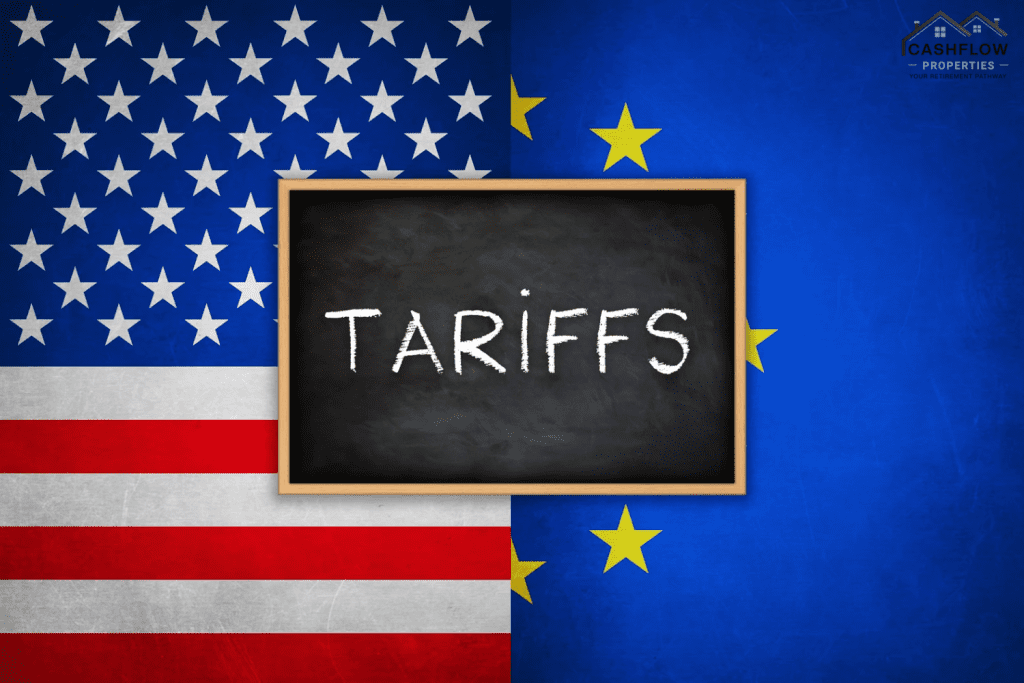
Australia’s economy, deeply intertwined with global trade, is experiencing significant shifts due to the resurgence of protectionist policies, notably under the second Trump administration in the United States. The imposition of new tariffs has introduced a complex web of challenges and opportunities, affecting various sectors and prompting strategic responses from businesses and policymakers alike.
1. Direct Impact on Key Export Sectors
The reintroduction of U.S. tariffs i.e. 25% on steel and aluminum and 10% on a broad range of imports which has directly affected Australian exporters. In 2024, Australia exported approximately A$819 million worth of steel and aluminum to the U.S., accounting for about 11.3% of its global exports in these commodities . With the full 25% tariff restored in 2025, these exports face higher costs, likely reducing their volume and value significantly. Australian steel exports to the U.S. could decline by 50% or more, as U.S. buyers turn to cheaper sources or domestic supply. This translates into an annual export revenue loss on the order of US$250–300 million for steel and aluminum combined .
The agricultural sector is also feeling the pinch. Tariffs on Australian beef, wine, and dairy products have led to reduced demand in key markets, with the agricultural sector experiencing a 1.8% drop in share prices following the tariff announcements . Manufacturing has not been spared either; increased costs of imported raw materials and components have affected the competitiveness of Australian manufacturers, leading to a 2.1% decline in share prices in the manufacturing sector .
2. Indirect Effects via China and Global Trade Dynamics
China, Australia’s largest trading partner, accounting for $A178.6 billion (6.6% of nominal GDP) of exports in 2024, is also entangled in the U.S. tariff web . The U.S. announced a 10% tariff on imports from China, following a previous 10% increase, raising the effective tariff level to 23%. These tariffs are expected to weigh on China’s export revenue, potentially leading to a slowdown in China’s economic activity. Such a slowdown would soften demand for Australian exports, particularly commodities like iron ore and coal, leading to lower export revenues and impacting the share prices of major mining companies.
Moreover, the Australian dollar has depreciated nearly 10% since November, reaching a five-year low after the tariffs were flagged . While a weaker Australian dollar can make exports more competitive, it also raises the cost of imports, contributing to inflationary pressures domestically.
3. Inflationary Pressures and Monetary Policy Responses
The tariffs have introduced inflationary pressures in the Australian economy. Higher costs for businesses, due to increased prices of imported goods and raw materials, are being passed on to consumers, contributing to inflation. Inflation in Australia is expected to rise by 0.5% due to increased costs from tariffs .
In response, the Reserve Bank of Australia (RBA) is anticipated to proceed with rate cuts through the rest of the year to support economic growth . Lower interest rates could boost housing demand, as mortgage costs decrease, leading to higher borrowing capacity for homebuyers. This could further drive up property prices in cities like Sydney and Melbourne.
4. Sector-Specific Impacts

Mining and Resources: Australia is a major exporter of commodities such as iron ore, coal, and natural gas. Tariffs on these products can reduce demand from key markets, particularly China, leading to lower export revenues and impacting the share prices of major mining companies like BHP and Rio Tinto. The mining sector saw a decline of 2.5% in share prices following the tariff announcements on 3 February 2025.
Agriculture: Australian agricultural exports, including beef, wine, and dairy, may face reduced demand due to higher prices resulting from tariffs. This can negatively impact the agricultural sector and related industries. The agricultural sector experienced a 1.8% drop in share prices .
Manufacturing: Increased costs of imported raw materialsand components can affect the competitiveness of Australian manufacturers, leading to potential declines in production and profitability. The manufacturing sector saw a 2.1% decline in share prices .
Film Industry: Queensland’s film industry is facing a crisisfollowing U.S. President Donald Trump’s announcement of a proposed 100% tariff on movies produced outside the U.S. The plan threatens a booming local sector that supports over 4,000 jobs and contributes $582 million annually .
5. Strategic Responses: Diversification and Policy Measures
In light of these challenges, Australian companies are adopting several strategies to mitigate the impact of U.S. tariffs:
Flexible Contracting: Companies are negotiating adaptable agreements to accommodate price fluctuations and changing external factors, such as tariffs or other trade policies .
Diversification: Businesses are reducing reliance on U.S. export markets by expanding trade relations with other partners, like China, the EU, and Southeast Asia, to make up for the lost demand .
Financial Hedging: Companies are using currency and commodity hedging strategies to manage tariff-related expenses, helping to mitigate the impact of higher costs caused by tariffs .
Policymakers are also playing a crucial role. Australian Prime Minister Anthony Albanese has stressed the need for Australian exporters to remain competitive despite global trade challenges. Government support can boost Australian exports by ensuring that products offer added-value technology that others can’t easily compete with, creating a competitive advantage for Australian firms .
Interest Rate Cuts: What It Means for the Property Market and Why Now is the Time to Invest
The Reserve Bank of Australia (RBA) is expected to begin cutting interest rates as inflation continues to ease. After a cycle of monetary tightening to contain rising prices, recent economic indicators suggest that the peak of the rate hike cycle has passed. For investors, especially in the property market, this shift signals an emerging opportunity to enter or expand in a market poised for renewed growth.
Understanding the Economic Shift
Australia’s Consumer Price Index (CPI) has shown signs of cooling, dropping from its peak in December 2022 to March 2024. While still above the RBA’s target range of 2 to 3 percent, the consistent decline is creating conditions for a potential rate cut. Economists from major financial institutions such as Westpac and ANZ have revised their forecasts, anticipating the RBA to initiate interest rate reductions between late 2024 and mid-2025.
Historically, falling interest rates lead to increased consumer confidence, lower loan repayment costs, and greater accessibility to finance. For the property sector, these effects typically translate into higher buyer activity, improved investor sentiment, and rising property prices.
Why This is Significant for Property Investors
With interest rate cuts on the horizon, the cost of borrowing is expected to drop, making home loans more affordable. This will enhance investor cash flow, strengthen holding capacity, and improve long-term returns.
Demand is set to rise as first-home buyers and upgraders re-enter the market. Combined with Australia’s persistent housing shortage, this will push property prices and rental yields higher.
Rental income remains attractive, supported by low vacancy rates—currently under 1.5 percent nationally.
Unlike volatile financial assets, property is a tangible investment and a reliable hedge against inflation. As rates ease, the relative risk of property investment declines, enhancing its appeal.
Why Consider Moving Investments from Shares to Property
Global equity markets are facing increased volatility due to geopolitical tensions, commodity swings, and central bank uncertainty. Sectors like tech and mining have seen major corrections.
In contrast, Australian real estate has shown resilience. Cities such as Brisbane, Adelaide, and Perth posted gains even amid rate hikes. According to the March 2024 report, capital city prices are already rebounding, with Sydney and Brisbane reaching new peaks.
Property offers steady rental income and long-term capital growth. It’s less susceptible to short-term shocks, making it a safer bet for medium- to long-term investors.
With Australia expecting a population surge of 1.5 million over five years, housing demand will only intensify—further cementing property’s growth potential.
Where the Opportunity Lies

Growth corridors and regional hubs near capital cities offer strong prospects, especially where infrastructure development is underway.
New builds and house-and-land packages provide tax advantages and rental appeal. SMSF investors also benefit from property’s stability and transparency.
As rates fall, entry into the market becomes more competitive. Early movers stand to gain the most from the next property upswing.
Closing Thoughts
Rising tariffs are reshaping Australia’s economy impacting exports, pushing up costs, and creating broader inflationary pressures. However, these shifts also make property investment more compelling.
Interest rate cuts by the RBA signal a pivotal economic shift. While business sentiment may improve, it’s the real estate sector that offers the most tangible benefits for investors in today’s uncertain environment.
As share markets remain volatile, property shines as a stable, income-generating asset. With tight supply, strong population growth, and improving borrowing conditions, the fundamentals for property investment remain robust.
For those looking to protect and build wealth, now is the time to pivot from risky markets to the security of bricks and mortar. Property is where the smart money is heading—are you ready to follow?

